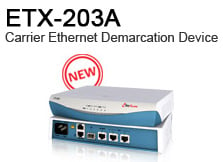Another Looks at CIOs and Carrier Ethernet
With CIOs increasingly focused on communications and knowledge management tools, such as mobility and collaboration, Carrier Ethernet is helping businesses to improve these technologies.
Carrier Ethernet is a ubiquitous, standardized service that can be delivered not only over traditional (native) Ethernet-based networks but also over other transport technologies, such as native Ethernet sources, MPLS-based Layer 2 VPNs, IEEE (News - Alert) 802.1ad Provider Bridges and Ethernet over SONET.
Last week, TMCnet reported on a recent demonstration by RAD Data Communications (News - Alert) which outlines several benefits of Carrier Ethernet for CIOs. RAD also outlined what kind of service levels and SLAs CIOs should expect, such as specific definitions of service levels and guarantees for key performance indicators. This week, TMCnet is following up.
A business-grade SLA for Carrier Ethernet services will typically include the following:
connection rates; class of service (CoS) levels definition and traffic priority settings; bandwidth commitments per CoS; Quality of Service (QoS) KPI (Key Performance Indicators) guarantees; monitoring and reporting; service and support hours, response and repair times; restrictions; and credits/SLA violation remedies.
In addition, businesses should choose a service provider that can provide performance reports with different reporting options.
According to RAD Data Communications (News - Alert), service providers can now implement the following capabilities in their networks:
- Traffic and bandwidth management for multilevel QoS;
- Performance monitoring and reporting;
- Fault detection and repair; and
- Resiliency and protection.
In order for these attributes to be effective, they need to be implemented at the service hand-off point, i.e., in the service provider’s CPE (also called Ethernet demarcation) installed at customer premises, according to RAD. Business-grade services require smart Ethernet demarcation devices to be installed at customer premises.
Most service providers are adding various Carrier Ethernet “flavors” to their WAN service offerings, according to RAD’s report. Knowing what options are available and then choosing the best Carrier Ethernet services can help CIOs lower costs and greatly improve efficiencies.
Want to learn more about the latest in communications and technology? Then be sure to attend ITEXPO West 2011, taking place Sept. 13-15, 2011, in Austin, Texas. ITEXPO (News - Alert) offers an educational program to help corporate decision makers select the right IP-based voice, video, fax and unified communications solutions to improve their operations. It's also where service providers learn how to profitably roll out the services their subscribers are clamoring for – and where resellers can learn about new growth opportunities. To register, click here.
Erin Harrison is Executive Editor, Strategic Initiatives, for TMC, where she oversees the company's strategic editorial initiatives, including the launch of several new print and online initiatives. She plays an active role in the print publications and TMCnet, covering IP communications, information technology and other related topics. To read more of Erin's articles, please visit her columnist page.
Edited by Carrie Schmelkin

 QUICK LINKS
QUICK LINKS 

